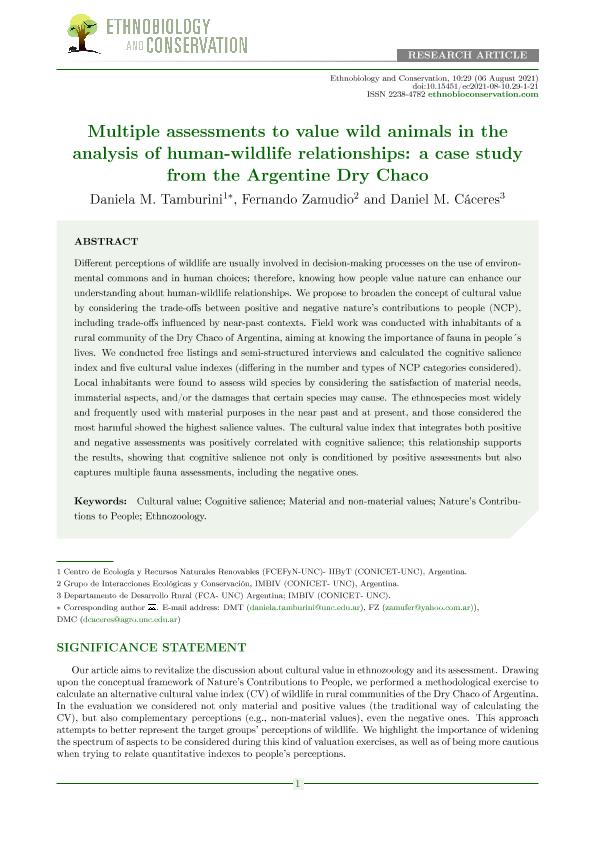Mostrar el registro sencillo del ítem
dc.contributor.author
Tamburini, Daniela Maria

dc.contributor.author
Zamudio, Fernando

dc.contributor.author
Caceres, Daniel Mario

dc.date.available
2022-10-11T12:45:36Z
dc.date.issued
2021-08-06
dc.identifier.citation
Tamburini, Daniela Maria; Zamudio, Fernando; Caceres, Daniel Mario; Multiple assessments to value wild animals in the analysis of human-wildlife relationships: A case study from the Argentine Dry Chaco; Universidade Federal Rural de Pernambuco; Ethnobiology and Conservation; 10; 6-8-2021; 1-21
dc.identifier.issn
2238-4782
dc.identifier.uri
http://hdl.handle.net/11336/172438
dc.description.abstract
Different perceptions of wildlife are usually involved in decision-making processes on the use of environmental commons and in human choices; therefore, knowing how people value nature can enhance our understanding about human-wildlife relationships. We propose to broaden the concept of cultural value by considering the trade-offs between positive and negative nature?s contributions to people (NCP), including trade-offs influenced by near-past contexts. Field work was conducted with inhabitants of a rural community of the Dry Chaco of Argentina, aiming at knowing the importance of fauna in people´s lives. We conducted free listings and semi-structured interviews and calculated the cognitive salience<br />index and five cultural value indexes (differing in the number and types of NCP categories considered). Local inhabitants were found to assess wild species by considering the satisfaction of material needs, immaterial aspects, and/or the damages that certain species may cause. The ethnospecies most widely and frequently used with material purposes in the near past and at present, and those considered the most harmful showed the highest salience values. The cultural value index that integrates both positive and negative assessments was positively correlated with cognitive salience; this relationship supports the results, showing that cognitive salience not only is conditioned by positive assessments but also captures multiple fauna assessments, including the negative ones.
dc.format
application/pdf
dc.language.iso
eng
dc.publisher
Universidade Federal Rural de Pernambuco
dc.rights
info:eu-repo/semantics/openAccess
dc.rights.uri
https://creativecommons.org/licenses/by-nc-sa/2.5/ar/
dc.subject
CULTURAL VALUE
dc.subject
COGNITIVE SALIENCE
dc.subject
MATERIAL AND NON-MATERIAL VALUES
dc.subject
NATURE'S CONTRIBUTION TO PEOPLE
dc.subject
ETHNOZOOLOGY
dc.subject.classification
Otros Tópicos Biológicos

dc.subject.classification
Ciencias Biológicas

dc.subject.classification
CIENCIAS NATURALES Y EXACTAS

dc.title
Multiple assessments to value wild animals in the analysis of human-wildlife relationships: A case study from the Argentine Dry Chaco
dc.type
info:eu-repo/semantics/article
dc.type
info:ar-repo/semantics/artículo
dc.type
info:eu-repo/semantics/publishedVersion
dc.date.updated
2022-09-22T10:24:02Z
dc.journal.volume
10
dc.journal.pagination
1-21
dc.journal.pais
Brasil

dc.journal.ciudad
Pernamburco
dc.description.fil
Fil: Tamburini, Daniela Maria. Universidad Nacional de Córdoba. Facultad de Ciencias Exactas, Físicas y Naturales. Centro de Ecología y Recursos Naturales Renovables; Argentina
dc.description.fil
Fil: Zamudio, Fernando. Consejo Nacional de Investigaciones Científicas y Técnicas. Centro Científico Tecnológico Conicet - Córdoba. Instituto Multidisciplinario de Biología Vegetal. Universidad Nacional de Córdoba. Facultad de Ciencias Exactas Físicas y Naturales. Instituto Multidisciplinario de Biología Vegetal; Argentina
dc.description.fil
Fil: Caceres, Daniel Mario. Universidad Nacional de Córdoba. Facultad de Ciencias Agropecuarias. Departamento de Desarrollo Rural; Argentina
dc.journal.title
Ethnobiology and Conservation
dc.relation.alternativeid
info:eu-repo/semantics/altIdentifier/doi/http://dx.doi.org/10.15451/ec2021-08-10.29-1-21
dc.relation.alternativeid
info:eu-repo/semantics/altIdentifier/url/https://www.ethnobioconservation.com/index.php/ebc/issue/view/23
Archivos asociados
